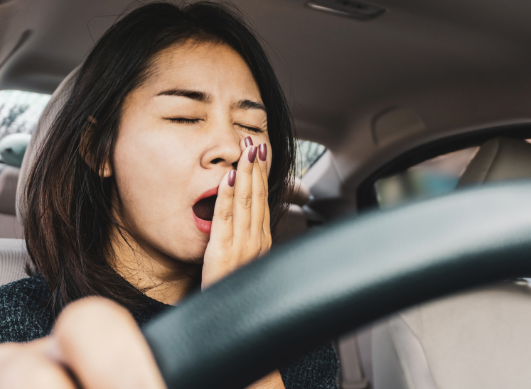Medications and driving: Are your prescriptions putting you at risk behind the wheel?
Published 26 Apr 2025 • By Somya Pokharna
When most people think about impaired driving, they picture someone under the influence of alcohol or illicit drugs. But here’s a surprising fact: many everyday prescription and over-the-counter medications can impair your ability to drive. From common allergy tablets to sleep aids and anxiety medications, even drugs taken exactly as prescribed can cause drowsiness, blurred vision, slower reaction times, and poor coordination behind the wheel.
So, which medications are most likely to interfere with safe driving? How can you recognize the warning signs? And what can you do to protect yourself and others on the road?
Buckle up, we’re about to take a closer look at the surprising connection between your medicine cabinet and your driving license.

Prescription drugs are involved in 46.5% of fatal drugged driving crashes, making them the most commonly detected substances in such incidents, even more than illegal drugs or alcohol. What’s more concerning is that many people are unaware that everyday medications, even when taken as prescribed, can interfere with safe driving.
How do medications affect your ability to drive?
Driving might feel automatic, but it’s actually a complex task that relies on quick thinking, sharp senses, steady coordination, and fast reflexes. Some medications can disrupt these abilities by affecting your brain, eyes, and muscles. Here's how:
- Delayed reaction times: Some drugs slow brain processing, making it harder to respond quickly to sudden changes, like a car braking ahead.
- Blurred or distorted vision: Medications can affect your eyesight, making it difficult to read road signs, judge distances, or spot pedestrians.
- Drowsiness and fatigue: Sedating drugs, including many sleep aids and antihistamines, can cause you to nod off or zone out behind the wheel.
- Cognitive fog: Medicines that impact attention or decision-making can leave you confused, distracted, or slow to react.
- Impaired coordination: Muscle relaxants and similar drugs can affect balance, hand-eye coordination, and the ability to control a vehicle smoothly.
These risks are particularly pronounced in older adults. As we age, our bodies metabolize drugs more slowly, which means the effects can last longer and be more intense. Many older individuals also take multiple medications, a situation known as polypharmacy, which increases the chance of side effects or interactions that impair driving. Conditions like chronic pain, insomnia, and anxiety, which are often treated with high-risk medications, are also more prevalent in this age group. This creates a perfect storm of physiological and pharmacological factors that make medication-related driving impairment more likely, and more dangerous, for older adults.
Which medications pose the greatest risk of impairing driving?
Some of the drug classes most associated with driving impairment are as follows:
Opioids
Examples: Oxycodone, Morphine, Codeine
Opioids are powerful pain relievers that work by dulling pain signals in the brain. Unfortunately, they also suppress activity in the central nervous system, causing drowsiness, dizziness, slowed breathing, and impaired attention. Even low doses can affect alertness and motor coordination, increasing crash risk, especially in new or long-term users.
Benzodiazepines
Examples: Diazepam, Lorazepam, Clonazepam, Alprazolam
Used for anxiety, panic disorders, and sleep problems, benzodiazepines enhance the effects of GABA, a brain-calming chemical. This leads to sedation, slower reflexes, impaired balance, and reduced mental sharpness. These effects can last into the next day, especially with longer-acting forms.
Non-benzodiazepine sleep aids
Examples: Zolpidem, Zaleplon
Often referred to as “Z-drugs,” these medications are prescribed for insomnia. While promoted as safer alternatives to benzodiazepines, they still carry risks. Zolpidem in particular can impair driving the morning after use, with slowed reaction times and drowsiness. Zaleplon has a shorter half-life and may be less impairing when taken at night.
Antidepressants
Examples: Fluoxetine, Sertraline, Amitriptyline, Duloxetine
Antidepressants, including SSRIs, SNRIs, and tricyclics, can cause drowsiness, blurred vision, slowed thinking, or dizziness, especially when first starting treatment or adjusting doses. Tricyclic antidepressants like amitriptyline are particularly sedating and have been linked to increased crash risk.
Antihistamines
Examples: Diphenhydramine, Hydroxyzine, Dimenhydrinate
These medications are used to treat allergies, nausea, or colds, but first-generation antihistamines are notorious for causing drowsiness and impaired motor skills. In fact, one dose of diphenhydramine has been shown to impair driving as much as being over the legal blood alcohol limit.
Muscle relaxants
Examples: Methocarbamol
Muscle relaxants are commonly prescribed for back or neck pain. They can cause extreme sedation, confusion, blurred vision, and poor coordination. These side effects are especially pronounced when combined with other central nervous system depressants like opioids or sleep aids.
Antipsychotics
Examples: Olanzapine, Risperidone, Quetiapine
These medications are prescribed for schizophrenia, bipolar disorder, and severe depression. They can lead to drowsiness, slowed movements, blurred vision, and reduced judgment, making driving risky, especially in early treatment phases.
Seizure medications (antiepileptics)
Examples: Valproic acid, Carbamazepine, Phenytoin
Designed to stabilize brain activity, antiepileptic drugs may also cause dizziness, fatigue, and motor coordination issues. These effects can be unpredictable and worsen when doses are missed or adjusted.
Stimulants
Examples: Methylphenidate, Pseudoephedrine
Although stimulants are used to increase alertness, especially in ADHD or narcolepsy, they can lead to overconfidence, jitteriness, irritability, and risky decision-making. OTC decongestants like pseudoephedrine can also affect driving when misused or combined with other meds.
Cannabis and CBD products
Examples: THC, CBD oil, edibles, topical cannabis products
Though often seen as harmless, cannabis (especially THC-containing products) can cause delayed reactions, drowsiness, and distorted perception. Even CBD, often marketed as non-intoxicating, may cause sleepiness and reduced focus, especially in high doses.
How can you stay safe behind the wheel when you're on medication?
If you're taking prescription or over-the-counter medications, it doesn't necessarily mean you have to hang up your car keys. But it does mean you need to be more mindful of how your body reacts and take proactive steps to protect yourself and others on the road.
Here are some essential ways to drive safely while managing your medications:
- Watch out for warning signs: If you feel foggy, dizzy, unusually tired, or your vision is blurry, don't ignore it. These could be signs that your medication is impairing your driving ability, even if it’s something you've taken many times before. Feeling “off” behind the wheel is a reason to stop and reassess, not push through.
QUICK TIP: When in doubt, don't drive until you know how the medication affects you, especially if you're starting something new or changing doses. And if you ever feel unsure, pull over, rest, or call someone for a ride. - Read the label and warnings: Medication packaging and leaflets often include specific cautions like “do not operate heavy machinery” or “may cause drowsiness.” That includes driving. Pay close attention, especially to first-time prescriptions and combination products like cold and flu remedies. For extra safety, or if you've lost the label, use online resources like drug interaction checkers to identify medications that could impair your driving or interact with others you're taking.
- Talk to your doctor or pharmacist: Before starting any new medication, or if you're already taking multiple drugs, ask your healthcare provider whether it's safe to drive. They can help adjust your dosage, change the timing, or switch you to a safer alternative if necessary.
- Avoid alcohol: Alcohol amplifies the sedative effects of many medications, even over-the-counter ones like antihistamines. Combining the two significantly increases your risk of impaired driving and can be dangerous, even in small amounts.
- Time your dose wisely: If your medication causes drowsiness or delayed reactions, consider taking it at night or, ensuring a long enough window before you get behind the wheel. Some drugs, like sleep aids, may still impair driving the following morning.
- Test your reaction before driving: Don’t assume you'll be fine. Try your new medication when you don’t need to drive and observe how it affects your alertness, focus, and coordination. This is especially important for medications that act on the central nervous system.
- Consider safer alternatives: For medications known to impair driving, like long-acting benzodiazepines or first-generation antihistamines, there may be better options. Newer drugs with fewer sedative effects could be just as effective and safer on the road.
Key takeaways
Medication-impaired driving is more common, and more dangerous, than many people realize. From prescription sleep aids to everyday allergy pills, even medications taken as directed can affect your ability to drive safely. This risk is especially significant for older adults, who often take multiple medications and may be more sensitive to their effects.
By staying informed, monitoring how you feel, and talking openly with your healthcare providers, you can make smarter choices behind the wheel. Remember, staying safe on the road isn’t just about following traffic laws, it’s also about knowing what’s in your system before you turn the key.
Did you find this article helpful?
Give it a “Like” and share your thoughts and questions with the community in the comments below!
Take care!
Sources:
A Gowan, J. (2022). Medicines and driving in older people. Journal of Pharmacy Practice and Research, 52(3), 254-262.
California DMV. (2023, August 18). Prescription Medications and Driving: What Are the Hazards? California DMV.
de Gier, J. J., Javier Alvarez, F., Mercier-Guyon, C., & Verstraete, A. G. (2009). Prescribing and dispensing guidelines for medicinal drugs affecting driving performance. In Drugs, driving and traffic safety (pp. 121-134). Basel: Birkhäuser Basel.
de Waard, D., & Brookhuis, K. A. (2000). Drug effects on driving performance. Annals of internal medicine, 133(8), 656.
FDA. (2024). Avoid driving impaired with these tips from FDA. U.S. Food and Drug Administration. https://www.fda.gov/consumers/consumer-updates/some-medicines-and-driving-dont-mix
Galski, T., Williams, J. B., & Ehle, H. T. (2000). Effects of opioids on driving ability. Journal of pain and symptom management, 19(3), 200-208.
Goad, K. (2024, April 24). 7 Medications That Don’t Mix With Driving. AARP.
Government of Yukon. (2023, March 3). Know the medications that impair your driving. Yukon.ca.
Hetland, A., & Carr, D. B. (2014). Medications and impaired driving. The Annals of pharmacotherapy, 48(4), 494–506.
Riedel, W. J., Vermeeren, A., Van Boxtel, M. P. J., Vuurman, E. F. P. M., Verhey, F. R. J., Jolles, J., & Ramaekers, J. G. (1998). Mechanisms of drug‐induced driving impairment: a dimensional approach. Human Psychopharmacology: Clinical and Experimental, 13(S2), S49-S63.
Ulrich, A. (2022, October 24). What Drugs Impair Your Ability to Drive Safely? GoodRx.
Verster, J. C., & Mets, M. A. (2009). Psychoactive medication and traffic safety. International journal of environmental research and public health, 6(3), 1041-1054.
Verster, J. C., Veldhuijzen, D. S., & Volkerts, E. R. (2004). Residual effects of sleep medication on driving ability. Sleep medicine reviews, 8(4), 309-325.
Verster, J. C., Volkerts, E. R., Spence, D. W., Alford, C., & Pandi-Perumal, S. R. (2007). Effects of sleep medications on cognition, psychomotor skills, memory and driving performance in the elderly. Current Psychiatry Reviews, 3(4), 281-292.

 Facebook
Facebook Twitter
Twitter


